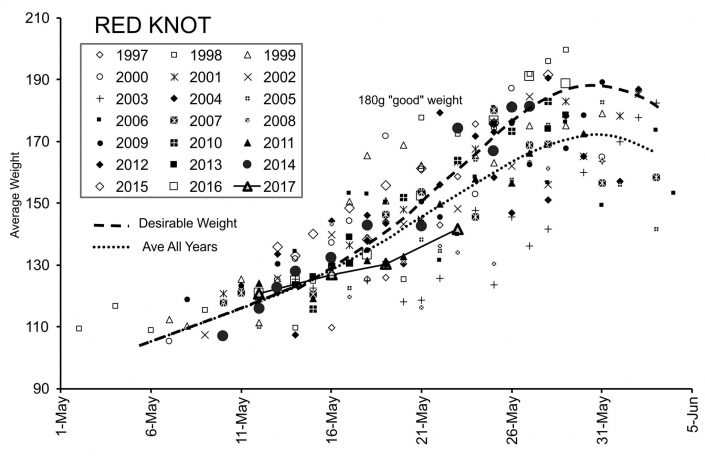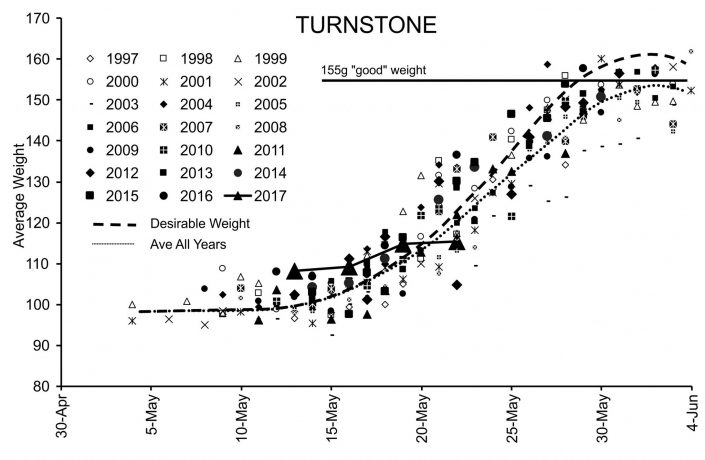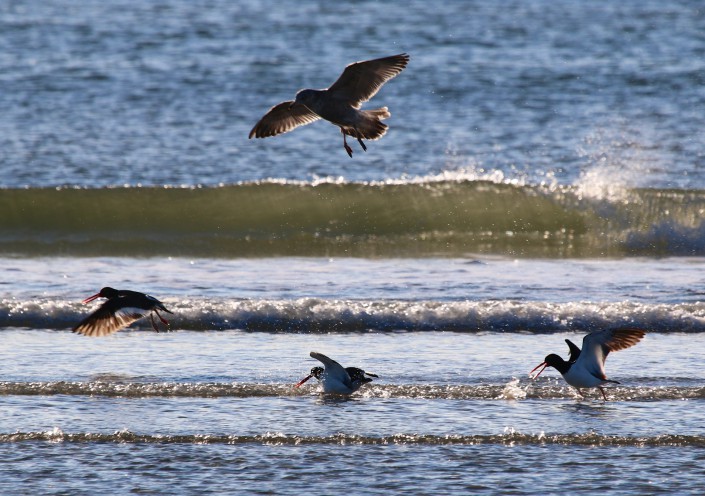In Dangerous Territory on the Delaware Bay
By Dr. Larry Niles, LJ Niles Associates, LLC
Four days ago, the shorebirds of Delaware Bay could look forward to a bright future. But in the last week their chances for survival and good production have diminished. In fact, they are as dismal as the cold drizzle pockmarking the murky water in front of our house on Reeds Beach.
The following two graphs tell the story. We captured red knots on May 12 and 16 that showed a normal, although not spectacular progression. Then we made a catch of knots on the 19th and again today on the 23rd, and in total they gained only 2 grams of fat per day. With an average weight of 144 grams at this late date and only 7 days to go before they must leave for the Arctic, their future looks bleak. If current conditions hold, the knots will suffer their worst year in 14 years. Turnstones fared no better gaining less than a gram per day on average.


So why this dismal report? Several factors are at work that were covered in my last post. The water temperature of the bay has only just exceeded the threshold for horseshoe crabs to start breeding in earnest. But the nights are cold and the water temperature remains cold. Last night was the first good crab spawn since the birds arrived and it was lackluster. Although there is some spawning in the creek mouth shoals and the lower beaches near Norburys Landing and Villas, our most productive beaches remain nearly devoid of crabs and crab eggs.
The second problem is still a mystery. At this stage only about half of the red knots have found their way into the bay. Weather patterns in the southern US could have been blocking migration for the last 5 days because adverse winds, poor visibility and rain impedes birds progress and could stop northward movement. The conditions have finally let up, so it possible a new cohort of birds might arrive any day. If so they will face a true food fight with many birds already here and desperate for eggs.

However, it may not be the adverse weather but choice that is keeping the population down. Today we learned of a red knot banded on May 16 this year by our counterparts in Delaware that was resighted in Cape Cod by Mark Faherty, the senior scientist for Massachusetts Audubon in Cape Cod. In other words, red knots and other shorebirds are coming to the bay finding too little food or too much competition for the food now available and choose to move on. This is very possible for the short distance migrants because they arrive earlier and have less weight to gain before leaving for the Arctic. Knots wintering in Tierra del Fuego, arrive later and in much worse condition, often times lose muscle mass to get here. They cannot recover that loss and still gain an extra 80 grams on their normal diet of mussels and clams.
We tried to test this second possibility today (May 23) after our red knot catch this morning. Humphrey Sitters, Amanda Dey and I surveyed the intertidal mud flats of the Atlantic Coast from Cape May to Stone Harbor looking closely at the mussel beds. We know that every year red knots, especially short distance birds, use mussels and to some extent clams, rather than come to the bay and feast on horseshoe crab eggs – simply because they can. We found 1700 knots, so it possible even more are spread out further up and down the coast.
In the end, it may turn out to be both explanations. The short distance knots are using the Atlantic Coast and the long-distance birds have yet to arrive. One should remember that the knot is federally listed in both Canada and the US primarily because of the dramatic declines in the long-distance winters. There is still a small window for a successful outcome. The next few days will tell the full story.
Dr. Larry Niles has led efforts to protect red knots and horseshoe crabs for over 30 years.
LEARN MORE
- Delaware Bay Shorebird Project
- 2017 Delaware Bay Shorebird Project blogs
- 2016 Delaware Bay Shorebird Project blogs
